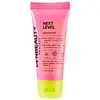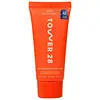What's inside
What's inside
 Key Ingredients
Key Ingredients

 Benefits
Benefits

 Concerns
Concerns

 Ingredients Side-by-side
Ingredients Side-by-side

Water
Skin ConditioningEthylhexyl Palmitate
EmollientPropanediol
SolventGlycerin
HumectantCetearyl Alcohol
Emollient1,2-Hexanediol
Skin ConditioningDicaprylyl Carbonate
EmollientNiacinamide
SmoothingSorbitan Stearate
EmulsifyingGlyceryl Stearate
EmollientBoerhavia Diffusa Root Extract
Skin ProtectingPinus Pinaster Bark Extract
AntioxidantCurcuma Longa Root Extract
MaskingSaccharide Isomerate
HumectantRibose
HumectantSodium PCA
HumectantPyrus Malus Fruit Extract
Skin ConditioningSophora Japonica Flower Extract
Skin ProtectingAllantoin
Skin ConditioningAdenosine
Skin ConditioningBetaine
HumectantCitric Acid
BufferingMangifera Indica Fruit Extract
Skin ConditioningPrunus Armeniaca Fruit Extract
Skin ConditioningRubus Idaeus Fruit Extract
AstringentCitrus Aurantifolia Peel Extract
CleansingCitrus Aurantium Dulcis Peel Extract
Emulsion StabilisingCitrus Paradisi Peel Extract
PerfumingCucumis Melo Fruit Extract
Skin ConditioningImpatiens Balsamina Flower Extract
AstringentVanilla Planifolia Fruit Extract
Skin ConditioningXanthan Gum
EmulsifyingCaprylic/Capric Triglyceride
MaskingCetearyl Olivate
Dipotassium Glycyrrhizate
HumectantDocosahexaenoic Acid
Skin ConditioningEicosapentaenoic Acid
EmollientGlyceryl Olivate
EmollientHydrogenated Rapeseed Alcohol
EmollientHydrogenated Vegetable Oil
EmollientTocopherol
AntioxidantTocopheryl Acetate
AntioxidantTrisodium Ethylenediamine Disuccinate
Tromethamine
BufferingPhosphatidylcholine
EmulsifyingPhytosphingosine
Skin ConditioningPolyglyceryl-4 Oleate
EmulsifyingSorbitan Isostearate
EmulsifyingSorbitan Olivate
EmulsifyingMica
Cosmetic ColorantSorbitol
HumectantStearic Acid
CleansingTetrasodium Glutamate Diacetate
Acrylates/C10-30 Alkyl Acrylate Crosspolymer
Emulsion StabilisingBehenyl Alcohol
EmollientHydroxyethyl Acrylate/Sodium Acryloyldimethyl Taurate Copolymer
Emulsion StabilisingHydroxyacetophenone
AntioxidantCI 77491
Cosmetic ColorantCI 77891
Cosmetic ColorantEthylhexylglycerin
Skin ConditioningWater, Ethylhexyl Palmitate, Propanediol, Glycerin, Cetearyl Alcohol, 1,2-Hexanediol, Dicaprylyl Carbonate, Niacinamide, Sorbitan Stearate, Glyceryl Stearate, Boerhavia Diffusa Root Extract, Pinus Pinaster Bark Extract, Curcuma Longa Root Extract, Saccharide Isomerate, Ribose, Sodium PCA, Pyrus Malus Fruit Extract, Sophora Japonica Flower Extract, Allantoin, Adenosine, Betaine, Citric Acid, Mangifera Indica Fruit Extract, Prunus Armeniaca Fruit Extract, Rubus Idaeus Fruit Extract, Citrus Aurantifolia Peel Extract, Citrus Aurantium Dulcis Peel Extract, Citrus Paradisi Peel Extract, Cucumis Melo Fruit Extract, Impatiens Balsamina Flower Extract, Vanilla Planifolia Fruit Extract, Xanthan Gum, Caprylic/Capric Triglyceride, Cetearyl Olivate, Dipotassium Glycyrrhizate, Docosahexaenoic Acid, Eicosapentaenoic Acid, Glyceryl Olivate, Hydrogenated Rapeseed Alcohol, Hydrogenated Vegetable Oil, Tocopherol, Tocopheryl Acetate, Trisodium Ethylenediamine Disuccinate, Tromethamine, Phosphatidylcholine, Phytosphingosine, Polyglyceryl-4 Oleate, Sorbitan Isostearate, Sorbitan Olivate, Mica, Sorbitol, Stearic Acid, Tetrasodium Glutamate Diacetate, Acrylates/C10-30 Alkyl Acrylate Crosspolymer, Behenyl Alcohol, Hydroxyethyl Acrylate/Sodium Acryloyldimethyl Taurate Copolymer, Hydroxyacetophenone, CI 77491, CI 77891, Ethylhexylglycerin
Water
Skin ConditioningGlycerin
HumectantCetyl Ethylhexanoate
EmollientCaprylic/Capric Triglyceride
MaskingPropanediol
Solvent1,2-Hexanediol
Skin ConditioningGlyceryl Stearate
EmollientCetearyl Alcohol
EmollientMicrocrystalline Cellulose
AbsorbentSodium Polyacrylate Starch
AbsorbentSclerotium Gum
Emulsion StabilisingTriolein
Skin ConditioningPotassium Cetyl Phosphate
EmulsifyingBehenyl Alcohol
EmollientAllantoin
Skin ConditioningCeramide NP
Skin ConditioningGlyceryl Dioleate
EmollientCellulose Gum
Emulsion StabilisingSodium Phytate
Pentylene Glycol
Skin ConditioningSodium Acetylated Hyaluronate
HumectantSodium Hyaluronate
HumectantSodium Hyaluronate Crosspolymer
HumectantHydrolyzed Sodium Hyaluronate
Skin ConditioningEthylhexylglycerin
Skin ConditioningWater, Glycerin, Cetyl Ethylhexanoate, Caprylic/Capric Triglyceride, Propanediol, 1,2-Hexanediol, Glyceryl Stearate, Cetearyl Alcohol, Microcrystalline Cellulose, Sodium Polyacrylate Starch, Sclerotium Gum, Triolein, Potassium Cetyl Phosphate, Behenyl Alcohol, Allantoin, Ceramide NP, Glyceryl Dioleate, Cellulose Gum, Sodium Phytate, Pentylene Glycol, Sodium Acetylated Hyaluronate, Sodium Hyaluronate, Sodium Hyaluronate Crosspolymer, Hydrolyzed Sodium Hyaluronate, Ethylhexylglycerin
 Reviews
Reviews

Ingredients Explained
These ingredients are found in both products.
Ingredients higher up in an ingredient list are typically present in a larger amount.
1,2-Hexanediol is a synthetic liquid and another multi-functional powerhouse.
It is a:
- Humectant, drawing moisture into the skin
- Emollient, helping to soften skin
- Solvent, dispersing and stabilizing formulas
- Preservative booster, enhancing the antimicrobial activity of other preservatives
Allantoin is a soothing ingredient known for its protective and moisturizingg properties. Because of this, it is often added to products with strong active ingredients.
Studies show higher concentrations of this ingredient can promote wound healing.
Though it can be derived from the comfrey plant, allantoin is produced synthetically for cosmetic products to ensure purity.
Learn more about AllantoinBehenyl Alcohol is a type of fatty alcohol (these are different from the drying, solvent alcohols).
Fatty Alcohols have hydrating properties and are most often used as an emollient or to thicken a product. They are usually derived from natural fats and oils; behenyl alcohol is derived from the fats of vegetable oils.
Emollients help keep your skin soft and hydrated by creating a film that traps moisture in.
In 2000, Behenyl Alcohol was approved by the US as medicine to reduce the duration of cold sores.
Learn more about Behenyl AlcoholThis ingredient is an emollient, solvent, and texture enhancer. It is considered a skin-softener by helping the skin prevent moisture loss.
It helps thicken a product's formula and makes it easier to spread by dissolving clumping compounds.
Caprylic Triglyceride is made by combining glycerin with coconut oil, forming a clear liquid.
While there is an assumption Caprylic Triglyceride can clog pores due to it being derived from coconut oil, there is no research supporting this.
Learn more about Caprylic/Capric TriglycerideCetearyl alcohol is a mixture of two fatty alcohols: cetyl alcohol and stearyl alcohol. It is mainly used as an emulsifier. Emulsifiers help prevent the separation of oils and products. Due to its composition, it can also be used to thicken a product or help create foam.
Cetearyl alcohol is an emollient. Emollients help soothe and hydrate the skin by trapping moisture.
Studies show Cetearyl alcohol is non-toxic and non-irritating. The FDA allows products labeled "alcohol-free" to have fatty alcohols.
This ingredient is usually derived from plant oils such as palm, vegetable, or coconut oils. There is debate on whether this ingredient will cause acne.
Due to the fatty acid base, this ingredient may not be Malassezia folliculitis safe.
Learn more about Cetearyl AlcoholEthylhexylglycerin (we can't pronounce this either) is commonly used as a preservative and skin softener. It is derived from glyceryl.
You might see Ethylhexylglycerin often paired with other preservatives such as phenoxyethanol. Ethylhexylglycerin has been found to increase the effectiveness of these other preservatives.
Glycerin is already naturally found in your skin. It helps moisturize and protect your skin.
A study from 2016 found glycerin to be more effective as a humectant than AHAs and hyaluronic acid.
As a humectant, it helps the skin stay hydrated by pulling moisture to your skin. The low molecular weight of glycerin allows it to pull moisture into the deeper layers of your skin.
Hydrated skin improves your skin barrier; Your skin barrier helps protect against irritants and bacteria.
Glycerin has also been found to have antimicrobial and antiviral properties. Due to these properties, glycerin is often used in wound and burn treatments.
In cosmetics, glycerin is usually derived from plants such as soybean or palm. However, it can also be sourced from animals, such as tallow or animal fat.
This ingredient is organic, colorless, odorless, and non-toxic.
Glycerin is the name for this ingredient in American English. British English uses Glycerol/Glycerine.
Learn more about GlycerinGlyceryl Stearate is a mix of glycerin and stearic acid.
It is used to stabilize the mixing of water and oil ingredients. By preventing these ingredients from separating, it can help elongate shelf life. It can also help thicken the product's texture.
As an emollient, it helps soften skin and supports barrier-replenishing ingredients.
In cosmetics, Glyceryl Stearate is often made from vegetable oils or synthetically produced.
This ingredient may not be fungal-acne safe
Fun fact: The human body also creates Glyceryl Stearate naturally.
Learn more about Glyceryl StearatePropanediol is an all-star ingredient. It softens, hydrates, and smooths the skin.
It’s often used to:
Propanediol is not likely to cause sensitivity and considered safe to use. It is derived from corn or petroleum with a clear color and no scent.
Learn more about PropanediolWater. It's the most common cosmetic ingredient of all. You'll usually see it at the top of ingredient lists, meaning that it makes up the largest part of the product.
So why is it so popular? Water most often acts as a solvent - this means that it helps dissolve other ingredients into the formulation.
You'll also recognize water as that liquid we all need to stay alive. If you see this, drink a glass of water. Stay hydrated!
Learn more about Water